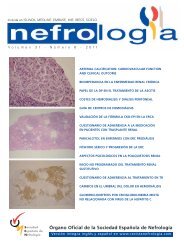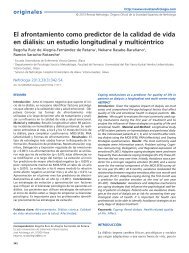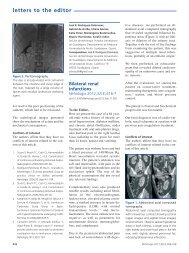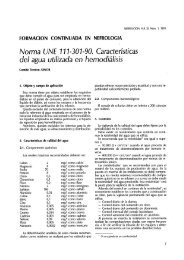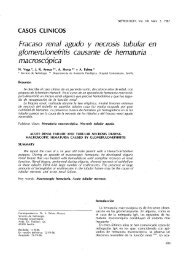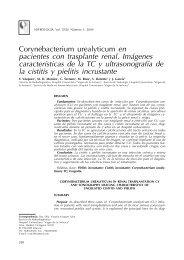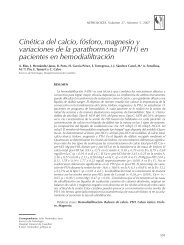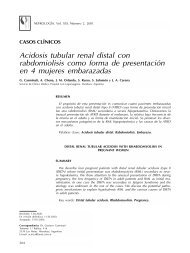PDF Número - NefrologÃa
PDF Número - NefrologÃa
PDF Número - NefrologÃa
Create successful ePaper yourself
Turn your PDF publications into a flip-book with our unique Google optimized e-Paper software.
originales<br />
Supranee Kongkham et al. Alpha Tocopherol Prevent CIN in Rats<br />
lowed by CIN induction, which was performed with drug administration<br />
into the tail vein. Drugs administered consisted<br />
of Indomethacin at a dose of 10 mg/kg, followed at 15min<br />
and at 30min later with N w -nitro-L-Arginine methyl ester<br />
(L-NAME) at a dose of 10mg/kg and with the low-osmolar,<br />
nonionic contrast medium agent (Iopromide, Schering AG,<br />
Germany) at a dose of 1600mg I/kg. This quantity is the dose<br />
of contrast medium that is standard for clinical use and for<br />
other relevant experiments in rat models. 20 As controls, rats<br />
were injected with PBS alone at each time.<br />
Histopathologic examination of renal tissues<br />
Both kidneys were excised immediately and cut into four<br />
equatorial sections; they were then washed twice with cold<br />
PBS. Two pieces of kidney were placed in 10% formaldehyde<br />
for histopathological examination. The other pieces were<br />
flash-frozen in liquid nitrogen, and stored at -70 o C until used<br />
for subsequent tissue analysis. Histological slides of the formalin-maintained<br />
samples were prepared and then counterstained<br />
with hematoxylin, eosin (H&E) and periodic acid<br />
schiff staining (PAS) using standard procedure. These steps<br />
were then followed by semi-quantitative analysis of the kidney<br />
sections by a pathologist functioning in a blind manner.<br />
Tubular necrosis and proteinaceous casts were graded according<br />
to a previous methodology 21 as follows: 0=no damage;<br />
1=mild (unicellular, patchy isolated damage); 2=moderate<br />
(damage 50% damage). The degree of medullary<br />
congestion was defined as: 0=no congestion; 1=mild (vascular<br />
congestion with identification of erythrocytes by x400<br />
magnification); 2=moderate (vascular congestion with identification<br />
of erythrocytes by x200 magnification); 3=severe<br />
(vascular congestion with identification of erythrocytes by<br />
x100 magnification) and 4=very severe (vascular congestion<br />
with identification of erythrocytes by x40 magnification).<br />
Moreover, interstitial edema was graded as follows: 0=no<br />
damage; 1=mild (unicellular, patchy isolated damage);<br />
2=moderate (damage 50% damage).<br />
Biochemical assay<br />
In order to measure the oxidative stress markers including the<br />
oxidation of lipids, the antioxidant enzyme, total antioxidant<br />
capacity (TAC) and the renal function test, the serum was separated<br />
from the blood that had been obtained from the heart<br />
and was kept at -20 o C until used. Renal function was investigated<br />
in serum blood urea nitrogen (BUN), and serum creatinine<br />
levels were determined using an automatic analyzer.<br />
Also, oxidative stress markers were measured in the kidneys.<br />
Renal tissue samples were prepared from 0.1g of frozen renal<br />
tissue which were homogenized in 1 ml of PBS (pH 7.2), and<br />
centrifuged at 10,000g for 10 min at 4 o C; supernatant was<br />
118<br />
then taken and kept at -80 o C until used. Protein contents in<br />
tissue homogenates were estimated by the Bradford method<br />
using bovine serum albumin as a standard.<br />
Lipid peroxidation, in term of malondialdehyde (MDA), was<br />
measured in the serum and in the renal tissue using thiobarbituric<br />
acid reactive substances (TBARS) assay, a method modified<br />
from that of Wong et al. 22 Briefly, 100ml of serum or renal<br />
tissue samples were subjected to 0.75ml of phosphoric<br />
acid solution (0.44M) and incubated at room temperature for<br />
10min; 0.5ml of TBA solution was then added. The mixtures<br />
were heated at 100 o C for 30 min. The samples were centrifuged<br />
at 4000g for 10 min. The absorbance of the supernatant<br />
was read at 532nm. The concentration of MDA was calculated<br />
from the 0–20µM of standard MDA using 1,1,3,3<br />
tetraethoxypropane. The results of the serum or renal MDA<br />
were expressed as µM or µM per mg of protein, respectively.<br />
TAC in serum and in renal tissue samples was determined by<br />
modified ABTS decolorization method as described by Re et<br />
al. 23 ABTS (7mM in final concentration), with potassium persulfate<br />
added (2.45mM final concentration), was kept<br />
overnight in the dark at room temperature. The initial absorbance<br />
of diluted ABTS radical cation solution was approximately<br />
0.7±0.02 at 734nm. After addition of 10 ml of sample<br />
or Trolox standard to 1ml of diluted ABTS, the absorbance<br />
was measured at 734nm at 1min after initial mixing. The TAC<br />
value was estimated by the reduction of the absorbance at<br />
734nm and calculated against a standard curve of the Trolox<br />
(0–10µM). The values of TAC were expressed in an equivalence<br />
of µM Trolox or µM Trolox/mg of protein, when measured<br />
in the serum or renal tissue samples, respectively.<br />
Renal SOD activity was also determined using the SOD kit<br />
(Sigma), following the manufacturing protocol. The SOD activity<br />
was measured and expressed as units per mg protein.<br />
Statistical analysis<br />
Results were presented as the means±SE. Student’s t-test<br />
(when two groups were considered) and one-way ANOVA<br />
were used to determine the significance of differences in<br />
group comparisons using SPSS software. A p value of less<br />
than 0.05 was considered to be as statistical significance.<br />
RESULTS<br />
Effect of vitamin E on the attenuation of renal<br />
dysfunction on CIN in rats<br />
All rats in the CM group exhibited a significant increase in<br />
BUN concentrations when compared to controls, and also the<br />
increase of BUN in this group was higher than that in the other<br />
four groups, as shown in (Table 1). No significant change<br />
Nefrologia 2013;33(1):116-23



